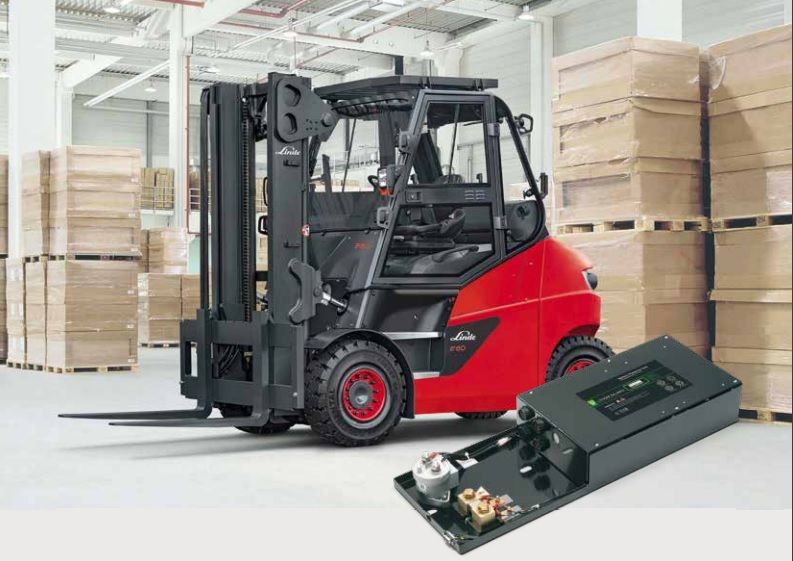Industrial traction Li-ion batteries
Due to the significant development in Lithium Technology over the last 5 years, the demand for replacing conventional Lead Acid (L/A) batteries with high performing Li-ION technology is rapidly increasing. This application note will summarize the key benefits of replacing Lead Acid batteries with Li-ION technology.
In addition, the application note describes how the Li-ION Battery should be constructed, where the Scalable Battery Protection Unit (s-BPU) is integrated and how the battery performance can be monitored and optimized.
Lithium-ion advantages
- With Li-ION batteries protected and monitored by an advanced Battery Management System (BMS), it is possible to avoid regular maintenance activities of the batteries, which are normally required with L/A.
- Reduce the energy consumption by 20-30% with Lithium battery, as the energy in charge and discharge will immediately will be optained/released in the battery and not as in L/A, wasted as heat.
- Improve the operation up-time by avoiding battery shift during operation.
- Increase operational range and/or reducing battery size. The ratio is 5:9 comparing Ah capacity between Li-ION (LFP) to L/A.
- Significantly increase cycle and calendar life as much 3 times with Li-ION (LFP) compared with L/A.
- Optimize the performance of the battery by configuration of parameters in the BMS through an advance PC toolbox.
- Opportunity to operate in -20 to +45 ﮿C.
- Li-ION batteries can be charged in a normal indoor environment and have no requirements for special rooms that can withstand after acid fumes and explosive hydrogen gasses.
- Li-ION batteries are a safe and environmentally clean product. They do not contain unhealthy acid substances and banned heavy metals such as lead. CO2 emissions (cradle to grave) can be reduced by 50% when replacing L/A

Installation notes

Basically the same battery box can be used as the one used with L/A.
For some applications like forklifts, the battery would require increased weight to achieve the counterweight. Steel plates can be used.

The LiBAL s-BPU unit can be placed into all existing battery boxes, and is designed to stand upright to have easy access to PC communication port, cell monitoring wires, I/O cables and HV power line.
The s-BPU also contain a re-activation contact that will re- engage the BMS after an auto-off incident. The configura-tion of the auto-off function is done through the s-BMS PRO PC software.

The prismatic cells can be placed inside an existing L/A battery box. Typically there will be a significant empty space due to the higher energy density of Li-ION (LFP) compared to L/A. As a rule of thumb it should be expected that the same opera-tional range can be achieved with half the nominal capacity.
The LFP cell can be supplied in 100, 180 and 200 AH capacity and can be mounted in 8s for 24 V, 15s for 48V and 24s for 80V.
The cells can be mounted in parallel configuration up to 2000Ah.

In this 48V example, the complete battery pack is assembled. The s-BPU is installed and the cell monitoring wire to each of the 15 cells in series are mounted for cell voltage sensing and balancing.
In addition, 4 temperature sensors are positioned in the pack to observe the battery pack temperature.
Each cell is connected with busbars and the power line goes through the BPU to measure current going in and out of the battery and to secure the battery with a charge/discharge relay. The BPU can be connected to a vehicle controller, motorcontroller and charger through CAN.

The BPU can be connected to the BMS PRO PC software configuration tool through an RS232 connection. A USB to RS232 is supplied with the PRO PC software configuration tool.
Configuration of the s-BPU though PRO PC software is facilitated by Lithium Balance application Engineers, who will provide up to 5 hours of free support along with the software license. The software license is a one off purchase.
Optional: Connect display/SOC indicator to s-BPU.
Optional: Connect to BatAnalytics datalogger and on-line battery data server.

The following considerations should be taken, where Lithium Balance application engineers can support:
- Configuration of BMS in the s-BPU unit to ensure correct cell setting, I/O, charge/discharge compensation.
- SOC optimization and of course safety regulations incl. Charger set-up.
- Battery configuration including mechanical drawing to ensure optimized size and battery cell configuration.
- Battery cost calculation incl. weight estimation, size, cell configuration.
- End-user TCO analysis consultancy to ensure correct parameters for calculation of cost/benefits between L/A and Lithium.
Technical information

